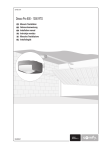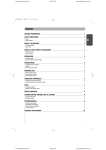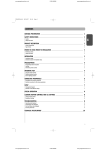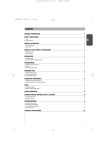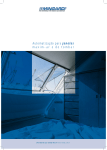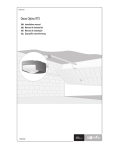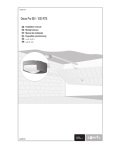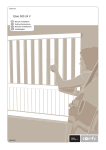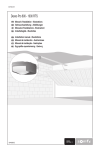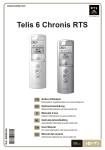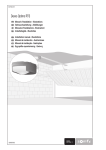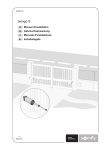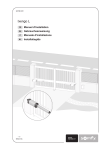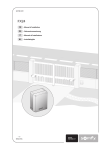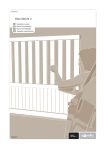Download Dexxo Pro io
Transcript
somfy.com Dexxo Pro io EN NL PL Installation manual Installatiegids Instrukcja montażu i i i i ok ok C Situo io Situo io A/M Situo io mobile 5048554E Telis 1 io Impresario Chronis io C Telis Composio io Keytis io Keytis Home io Keygo io GENERAL PRESENTATION����������������������������������������������� 2 SAFETY INSTRUCTIONS������������������������������������������������� 2 Caution2 Safety instructions 2 PRODUCT DESCRIPTION������������������������������������������������� 2 Product components Area of application 2 2 POINTS TO CHECK PRIOR TO INSTALLATION������������������������������� 3 Preliminary checks Safety instructions 3 3 INSTALLATION���������������������������������������������������������� 3 Installation height Detailed description of installation steps 3 3 PROGRAMMING�������������������������������������������������������� 5 Programming button description End limit setting and self-learning Keytis remote control description Keygo remote control description Fitting the battery for Keytis remote controls Programming Keytis remote controls Programming Keygo remote controls 5 5 5 5 6 6 7 OPERATING TEST������������������������������������������������������� 7 Using Keytis remote controls Using Keygo remote controls Obstacle detection function Built in lighting operation 7 7 7 7 CONNECTING PERIPHERALS��������������������������������������������� 8 Description of the various peripherals Electrical connections for the various peripherals 8 8 SETUP����������������������������������������������������������������� 9 General setup diagram Meanings of the various parameters 9 9 Programming Keygo IO remote controls for full and partial opening operation������������������������������������������ 10 CLEARING REMOTE CONTROLS AND ALL SETTINGS������������������������ 11 Clearing remote controls Resetting all settings 11 11 LOCKING PROGRAMMING����������������������������������������������� 11 REFITTING COVERS���������������������������������������������������� 11 TROUBLESHOOTING��������������������������������������������������� 12 Operating codes displayed Programming codes displayed Error and failure codes displayed Accessing stored data 12 12 12 12 TECHNICAL SPECIFICATIONS�������������������������������������������� 13 Dimensions13 io-homecontrol® provides advanced and secure radio technology that is easy to install. io-homecontrol® labelled products communicate with each other, improving comfort, security and energy savings. www.io-homecontrol.com 1 EN CONTENTS EN GENERAL PRESENTATION This product complies with the “safety, specific rules for powering vertically opening garage doors in residential use” requirements (standard EN 60335-2.95). When installed in line with these instructions and in compliance with the “Installation Checklist”, the product will be compliant with standards EN 13241-1 and EN 12453. The instructions referred to in the installation manual and instructions for use of this product are designed to prevent damage to property and personal injury along with compliance with the above standards. Failure to comply with these instructions absolves Somfy from any liability resulting from damage that may be caused. Dexxo Pro is a product that must be installed inside the garage with an integrated back-up control system. Somfy hereby declares that the device is compliant with the essential demands and other relevant requirements of directive 1999/5/CE. A declaration of compliance is available from the web site at www.somfy.com/ce (Dexxo Pro io). This product is suitable for use in the European Union and in Switzerland. SAFETY INSTRUCTIONS Caution These are important safety instructions. Always follow the instructions, incorrect installation may lead to serious injury. Safety instructions Before installing the motor drive unit, remove all unessential lines or chains and switch off all equipment that is not essential for motorised door operation. Before installing the motor drive unit, make sure that the door is in good mechanical condition, that it is properly balanced and that it opens and closes correctly. Locate all control systems at least 1.5 metres above floor level, making sure that they are visible from the entrance to the garage but safe from moving parts. Position the manual release cord no more than 1.8 metres above floor level. Where a removable release mechanism is used, we recommend storing it close to the door. Fix the label describing the manual release procedure close to the release mechanism. Fix the warning labels describing the hazards of door motion close to any fixed control mechanisms installed and make sure that the labels are clearly visible to the user. After installation, make sure that the mechanism is correctly adjusted and that the motor drive unit reverses its motion when the door encounters an obstacle that is at least 50 mm from floor level. After installation, make sure that no part of the door overhangs an area accessible to the public. After installation, make sure that the motor drive unit inhibits or stops the door opening motion when the door is loaded down with a 20 kg weight attached to a central position of the door’s bottom edge. In accordance with standard EN12453 concerning the safe use of motorised doors and gates, the remote control of an automatic garage door which is not visible to the user, particularly using the TAHOMA unit, always requires a photoelectric cell type safety device to be installed on this automatic function.Failure to comply with these instructions absolves SOMFY of any liability resulting from damage that may be caused. PRODUCT DESCRIPTION Product components Fig. 1 Key 1 2 3 4 5 6 7 8 9 10 11 12 13 14 15 Number 1 1 1 1 1 2 2 1 1 1 4 1 4 4 6 Description Motor head Motor cover Built-in light cover Lintel bracket Door bracket Ceiling bracket Motor head bracket Manual release cord Link arm Travel stop Chain retainer pad Power cable Hex. head M8x16 bolt Hex. head M8x12 bolt & washer HU8 nut Area of application Fig. 2 Key 16 17 19 20 21a 21b 21b1 21b2 22 23 24 25a 25b 26 27 Number 2 2 4 2 1 1 1 8 2 2 1 1 2 1 1 Description Shaft Circlips Self-shaping Ø 4x8 screw Special screw for plastic Ø 3.5x12 Single part rail Two part rail Sleeve Self-shaping Ø 4x8 screw HM8 self-locking nut Bracket Spacer Keytis 4 io remote control Keygo io remote control 230 V 40 W E14 socket light bulb Antenna Types of doors (Fig.2) A: Projecting up and over door. B: Sectional door: - if the door’s upper profile is a specific one, use the “sectional door mounting bracket” ref.: 9009390. - if the door surface exceeds 10 sq. metres, use the “sectional door adapter” ref.: 2400873. 2 EN C: Sideways opening sliding door: - for side wall mounting, use: - a belt transmission rail - an “adjustable cranked arm” ref.: 9014481. - for ceiling mounting, use: - an “articulated arm” ref.: 9014482. D: Swinging door. Use the swinging door kit, ref.: 2400459. E: Semi and non projecting door. Use: - a high performance transmission rail - “the semi and non projecting door kit” ref.: 2400458. Some doors of this type may prove impossible to automate. Contact SOMFY’s technical department. Door dimensions (Fig. 3) For maximum door heights, the motor travel can be optimised: •By installing the motor head at a 90° angle (Fig. 7- ). •By fixing the lintel bracket to the ceiling, behind the lintel itself by up to 200 mm (Fig. 5- ) •By cutting the link arm to size. POINTS TO CHECK PRIOR TO INSTALLATION Preliminary checks Check the garage door can be operated manually and runs smoothly. Ensure the door is in good mechanical condition (pulleys, mounts…) and is correctly balanced (spring tension). Remember that any work performed on door springs may be dangerous. The structure of your garage (walls, lintel, inside surfaces, cross members, door rails…) are used to mount the Dexxo Pro system. Reinforce them where necessary. Never splash water onto the system. Never install Dexxo Pro in a location where water may cause damage. The bottom edge of the door should be fitted with a rubber strip to avoid hard contact and enhance the contact surface. If the garage door is the only entry point into the garage, fit an external release (external release keylock (ref. 9012961) or an external release (ref. 9012962) and include a back-up battery (ref. 9001001). If the garage door includes a separate pedestrian door, the door must be fitted with an interlock to prevent garage door movement when the pedestrian door is open (pedestrian door safety kit ref. 2400657). If the garage door opens on to a public road, install an indicator light, such as a flashing orange light (ref. 9015171). If the garage door operates in automatic mode, install a photoelectric cell type safety system (ref. 9014994 or ref. 9013647) and a flashing orange light type indicator. Make sure that the door does not comprise any accessible parts. Unlocking the door may trigger uncontrolled door movement if the door is not balanced correctly. Safety instructions Safety instructions must be complied with throughout the installation process: •Take off any personal jewellery (bracelet, chain or others) during installation work. •During drilling and welding work, always wear safety glasses and suitable protection. •Always use suitable tools. •Take care when handling the motor drive system. •Never connect the mains power supply or the battery back-up system before completing the installation process. •Never use high pressure water systems for cleaning purposes. INSTALLATION Installation height Fig. 4 Measure the distance “D” between the door’s highest point and the ceiling. If “D” is between 35 and 200 mm, mount the complete system straight onto the ceiling. If “D” exceeds 200 mm, mount the complete assembly so that the height “H” falls between 10 and 200 mm. Detailed description of installation steps Fig. 5 to 15 Mounting the lintel bracket and the door bracket (Fig. 5) When installing the system directly onto the ceiling (flush with the ceiling), the lintel bracket can be mounted on the ceiling, if necessary recessed from the lintel by up to 200 mm max. (Fig. 5- ). 3 Assembling the two part rail (Fig. 6) EN [1] [2] [3]. Unfold the two parts of the rail. Ensure that the chain or belt is not twisted. [4]. Assemble the two parts of the rail using the sleeve. [5]. Mount the complete assembly using the eight mounting screws. [6]. Tighten the nut to tension the chain or belt. The compressed rubber must measure 18 and 20 mm. The mounting screws must not penetrate the rail (do not drill). When installing the system directly onto the ceiling, do not use the sleeve mounting screws. Fitting the rail onto the motor head (Fig. 7) Fitting the complete assembly onto the garage ceiling (Fig. 8 to 10) Fitting to the lintel bracket (Fig. 8) Ceiling mounting •Flush with the ceiling: mount the system directly onto the ceiling using the rail (Fig. 9). It is possible to add mounting points at the motor head level (Fig. 9- ). •Hung from the ceiling: two options: - mount the system at the motor head (Fig. 10- a ). - mount the system at the rail (Fig. 10- b ). To add an adjustable intermediate mounting along the rail, or a mounting at a dimension h between 250 mm and 550 mm, use the ceiling mounting kit ref.: 9014462 (Fig. 10- ). Fitting the arm onto the door and the trolley (Fig. 11) [1]. Release the trolley using the manual release cord. [2]. Bring the trolley up to the door. [3]. Attach the arm to the door bracket and the trolley. Adjusting and fastening the opening travel stop (Fig. 12) [1]. Release the trolley from the runner using the manual release mechanism and bring the door to the open position. Do not open the door fully, but position it so that it does not reach its own travel stop. [2]. Slot the travel stop (10) into the rail then turn it by 90°. [3]. Position the travel stop against the trolley. [4]. Moderately tighten down the mounting screw. Do not tighten the mounting screw all the way down. Excessive tightening can damage the screw and cause the travel stop not to remain in place. Fitting the chain retainer pads (Fig. 13) For chain rails only. These pads are used to limit spurious noise linked to chain friction within the rail. Position each of the pads in the first hole in the rail after the travel stop. Make sure that the pad is pressed in all the way so that its positioning pin is accessible outside of the rail. Checking the chain or belt tension (Fig. 14) The rails are supplied ready tensioned and inspected. If necessary, adjust the tensioning. The rubber or tension spring must never be fully compressed during operation. Connecting the mains power supply (Fig. 15) [1]. Remove the motor cover and the protective sheet. [2]. Fit the light bulb. [3]. Connect to the antenna. [4]. Connect to the mains supply. Plug the power cable into a suitable power outlet that complies with electric power requirements. The electric supply must be suitably protected (a fuse or circuit breaker with a 5 A rating) and a residual current device (30 mA). An omnipolar disconnection mechanism must be provided for the power supply: . by using a power cord with a mains splug that can be disconnected, or . by fitting a switch that ensures a contact separation distance of at least 3 mm for each pole (refer to standard EN60335-1). Make sure that the manual release cord is located at a maximum height of 1.80 metres off the ground. If necessary, extend the cord. 4 PROGRAMMING EN Programming button description . Press for 2 s: memorise remote controls . Press for 7 s: delete remote controls . Press for 0.5 s: call up and exit the setup menu . Press for 2 s: start learning . Press for 7 s: clear learning and settings . Stop learning . Selecting a setting . Modifying a setting value . Using the forced mode . Start the learning cycle . Confirm setting selection . Confirm setting value End limit setting and self-learning Fig. 16 For swinging doors, change the P9 setting before starting self-learning. [1].Press the “SET” button until the light comes on (2 s). The display shows “S2” [2]. Control the motor using the “+” or “-” buttons so that the transmission system runner moves to link up with the trolley and closes the door. •Pressing and holding the “-” button closes the door. Release the “-” button before the motor has time to force against the door. •Pressing and holding the “+” button opens the door. [3]. Adjust the closed position using the “+” or “-” buttons. Release the “-” button before the motor has time to force against the door. [4]. Press “OK” to validate the closed end limit position and start the self-learning cycle. The door runs through a complete Open Close cycle. •If learning was correct, the display will show “C1”. •If the learning cycle was not completed correctly, the display will show “S1”. During the learning cycle: •If the door is moving, pressing any button will stop the movement and interrupt the learning mode. •If the door is stopped, pressing “SET” once will exit the learning mode. You can call up the learning mode at any time, even when the learning cycle has already been executed and the display shows “C1”. Keytis remote control description Fig. 17a 1 Individual control buttons 2 General STOP button 3 General CLOSE button (Keytis 4 home io only) 4 Operation indicator light 5 Low battery indicator light On Intermittent Blinking 6 Closing clip 7 PROG button: programming the transmitter 8 KEY button: memorising the system key Keygo remote control description Fig. 17b 1 Individual control buttons 2 Operation indicator light On Intermittent Blinking 5 EN Fitting the battery for Keytis remote controls Fig. 18 Programming Keytis remote controls Fig. 19 to 23 . If the installation already comprises other io-homecontrol® products with at least one programmed remote control then you must perform the Memorising the system key step before programming the remote controls (Fig. 20). . If the Keytis io remote control to be programmed is the system’s first remote control, then go straight to Programming the Keytis remote control step (Fig. 21 to 23). The operations for memorising the system key and to program a remote control by copying another Keytis remote control are only possible at the installation location. To gain authorisation to transfer its system key or its programming, the previously programmed remote control must be able to establish radio communication with an installation receiver. Memorising the system key (Fig. 20). [1]. Set existing remote control no. 1 to the key transfer mode: •With a Keytis, Telis, Impresario, Composio remote control: press the “KEY” button until the green indicator comes on (two seconds). •With another remote control: refer to its documentation. [2]. Briefly press the “KEY” button on the new remote control. Wait for the confirmation beep (a few seconds). Programming the Keytis remote control (Fig. 21 to 23) Before programming the remote control, make sure that it has already memorised the system key. Each control button is programmed individually. A button that is already programmed cannot be programmed on a second receiver. To see if a button is already programmed, press it: •button programmed → green indicator comes on. •button not programmed → orange indicator comes on. To clear a previously programmed button, refer to the section on Clearing Keytis remote controls. There are two ways to program the remote control: •Programming from a Dexxo Pro motor. •Programming by copying a previously programmed Keytis remote control. Programming from a Dexxo Pro motor (Fig. 21) [1]. Press the “PROG” button on the Dexxo Pro until the light comes on (two seconds). [2]. Briefly press the “PROG” button on the remote control. Wait for the second beep and for the green indicator to start blinking quickly. This may take from a few seconds to around a minute depending on the number of products connected to the system. [3]. Briefly press the button chosen to control the Dexxo Pro motor. The remote control sounds a confirmation beep and the Dexxo Pro motor’s light blinks for five seconds. Programming by copying a previously programmed Keytis remote control •Completely copy the programming of a Keytis remote control (Fig. 22) This operation is used to copy all of the buttons programmed from an already programmed remote control. [1]. Press the “PROG” button on the previously programmed remote control until the green indicator comes on (two seconds). [2]. Briefly press the “PROG” button on the new remote control. Wait for the second beep and for the green indicator to start blinking rapidly (a few seconds). •Individually copy the programming of a Keytis remote control button (Fig. 23) This operation is used to copy the programming of a single button from an already programmed remote control. [1]. Press the “PROG” button on the previously programmed remote control until the green indicator comes on (two seconds). [2]. Briefly press the button to copy on the previously programmed remote control. [3]. Briefly press the “PROG” button on the new remote control. Wait for the confirmation beep (after a few seconds). [4]. Briefly press the button chosen to control Dexxo Pro on the new remote control. It is impossible to program Keytis remote controls in the following cases: . The remote control has not memorised the system key. . A number of installation receivers are in programming mode. . A number of remote controls are in key transfer or programming modes. Any incorrect programming is indicated by a series of fast beeps together with the orange indicator blinking on the Keytis remote control. At this stage in the installation process, the Dexxo Pro motor drive unit is ready to run. 6 Programming Keygo remote controls Fig. 24 and 25 Each control button is programmed individually. EN To clear a previously programmed button, refer to the section entitled "Clearing Keygo remote controls". There are two ways to program the remote control: •Programming from a Dexxo Pro motor. •Programming by copying a previously programmed Keygo io remote control. Programming from a Dexxo Pro motor (Fig. 24) [1]. Press the “PROG” button on the Dexxo Pro until the light comes on (2 seconds). [2]. Simultaneously press the outer right and outer left buttons on the remote control. The remote control indicator light flashes. [3]. Briefly press the selected button to actuate the Dexxo Pro motor. The light of the Dexxo Pro motor flashes for 5 seconds. Programming by copying a previously programmed Keygo io remote control (Fig. 25) This operation is used to copy the programming of a previously programmed remote control button. [1]. Simultaneously press the outer right and outer left buttons on the previously programmed remote control (A) until the green indicator light comes on (2 seconds). [2]. Press the button for 2 seconds to copy the previously programmed remote control (A). [3]. Simultaneously briefly press the outer right and outer left buttons on the new remote control (B). [4]. Briefly press the selected button to actuate the Dexxo Pro on the new remote control (B). At this stage in the installation process, the Dexxo Pro motor drive unit is ready to run. OPERATING TEST Using Keytis remote controls Fig. 26 Using Keygo remote controls Fig. 27 Obstacle detection function Fig. 28 and 29 The detection of an obstacle during door opening will stop the door (Fig. 28). The detection of an obstacle during door closure will reopen the door (Fig. 29). Make sure that obstacle detection works when the door encounters an obstacle 50 mm from the ground. Built in lighting operation The light will come on every time the motor drive unit is operated. It will go out automatically after one minute once the door stops. This time delay is adjustable (refer to the Setup chapter). Repetitive use which causes the light to stay on continually may result in an automatic cut-off condition triggered by the thermal cut out protection mechanism. 7 EN CONNECTING PERIPHERALS Description of the various peripherals Fig. 30 Key Description Key Description 1 2 3 4 5 Orange light Remote lighting Code keypad Keyswitch Aerial 6 7 8 9 10 Battery Pedestrian door safety kit Photoelectric cells Reflex type cells Sensor bar Electrical connections for the various peripherals Fig. 30 to 39 Cut the electric power supply to the motor before performing any work on peripherals. If the display remains off after working on the system, check the wiring (for possible short circuits or polarity reversals). General electrical diagram (Fig. 30) Photoelectric cells (Fig. 31) It is compulsory to install photoelectric cells: - If automatic closing is activated (P0=1) - If the automatic function is controlled remotely (not visible to the user) Two types of connections can be made: A: Standard (without self test): program the setting “P2” = 2. B: With self test: program the setting “P2” = 1. This means that an automatic test is conducted to check photoelectric cell operation every time the door operates. If the test fails, no door movement is possible. Reflex photoelectric cell (Fig. 32) With self test: program the setting “P2” = 1. This means that an automatic test is conducted to check photoelectric cell operation every time the door moves. If the test fails, no door movement is possible. Sensor bar (Fig. 33) With self test: program the setting “P2” = 1. This is used to perform an automatic test of sensor bar operation every time the door moves. If the test result is negative, no door movement is possible. Make sure you have correctly configured parameter “P2” taking into account the photoelectric cells or the sensor bar. Orange light (Fig. 34) Program the setting “P1” depending on the required operating mode: •Without warning before door movement: “P1” = 0. •With a 2 s warning before door movement: “P1” = 1. Code keypad (Fig. 35) Pedestrian door safety kit (Fig. 36) When the pedestrian door contact is fitted, it must be connected in place of the jumper normally fitted between terminals 5 and 6. If the pedestrian door contact is removed, the jumper between terminals 5 and 6. Battery (Fig. 37) Aerial (Fig. 38) Remote lighting (Fig. 39) Class 2 (double insulation) light units that are connected do not require an earth connection. Various types of lighting can be connected without exceeding a total power consumption of 500 W. 8 SETUP EN General setup diagram Fig. 40 Meanings of the various parameters Code P0 Description Operating mode Values 0: sequential 1: automatic closure P1 Orange warning light P2 Safety input 0: without advance warning 1: with 2 s advance warning 0: no safety mechanism 1: safety mechanism with self test 2: safety mechanism without self test P3 Obstacle detection sensitivity P4 Partial opening cycle 0: low sensitivity 1: low sensitivity 2: standard 3: high sensitivity 0: not valid 1: valid P5 Closing speed 0: slowest speed: approx. 3.5 cm/s to 9: fastest speed: approx. 18 cm/s By default, 6: approx. 12 cm/s P6 P7 Partially open position Closure approach speed Storing the position as illustrated in Fig. 42. 0: no slowdown 1: short soft stop 2: long soft stop P8 Opening speed P9 0: slowest speed: approx. 3.5 cm/s to 9: fastest speed: approx. 18 cm/s Choice of operating direction 0: direction 1: all types of doors except (type of door) swinging doors Comments Automatic closure mode operation is only possible if photoelectric cells are fitted, i.e. P2=1 or P2=2. In automatic closure mode, the door is automatically closed after the end of the time delay set with setting “t0”. If the garage opens onto a public road, always select with advance warning: P1=1. If value 0 is selected, the safety input is not taken into account. If value 1 is selected, the system’s self test is run at the start of every operating cycle. If value 2 is selected, the safety system runs without a self test: it is essential to test its proper operation every six months. If this setting is changed, it is essential to run the force measurement sequence at the end of the installation procedure or install a sensor bar. If the partial opening cycle is validated: For Keytis remote controls . a short press on the remote control button causes partial opening. . a long press on the remote control button causes full opening. For Keygo remote controls Pressing the button programmed for partial opening causes partial opening; pressing the button programmed for full opening causes full opening. When this parameter is activated, pressing a previously programmed remote control button will partially open the gate; an additional command must then be performed so that the button fully opens the gate again (refer to "Programming Keygo io remote controls for full and partial opening operation"). If this setting is changed, it is essential to run the force measurement sequence at the end of the installation procedure or install a sensor bar. If spurious detection of obstacles occurs when this parameter is modified, end limit setting and auto-programming will have to be carried out again. P7=0: the door does not slow before closure. P7=1: the door speed slows 20 centimetres before closure. P7=2: the door speed slows 50 centimetres before closure. If this setting is changed, it is essential to run the force measurement sequence at the end of the installation procedure or install a sensor bar. If spurious detection of obstacles occurs when this parameter is modified, end limit setting and auto-programming will have to be carried out again. If spurious detection of obstacles occurs when this parameter is modified, end limit setting and auto-programming will have to be carried out again. If this setting requires modification the end limit setting must be repeated along with self-learning. 1: direction 2: swinging doors A0 Safety action prior to opening (safety ADMAP) 0: no effect 1: movement rejected If value 1 is selected, triggering the safety input will inhibit door opening. A1 Safety action during closure 1: stop 2: stop + partial re-opening 3: fully reopen Value 1 is not allowed when using a sensor bar on the safety input. A2 Obstacle detection action 2: stop + partial re-opening during closure 3: fully reopen Automatic closure time delay 0 to 12 (time delay value = value x 10 s) 2: 20 s Lighting time delay 0 to 60 (time delay value = value x 10 s) 6: 60 s t0 t1 Remark: Due to the thermal cut out protection system, the integrated light may cut out automatically if it is used for an extended length of time. We therefore recommend selecting a light time delay in excess of 2 mn (t1=12 or 120s) only when remote lighting is used. (Boldface text = default values) 9 Programming example: setting the ”P7” closure approach speed (Fig. 41) EN Setting up a long soft stop function zone “P7” = 2. Special case: adjusting the position of the door for partial opening (Fig. 42) Select setting “P6” and validate by pressing “OK”. Move the door to the desired partially open position: . Pressing and holding the “-” button will close the door. . Pressing and holding the “+” button will open the door. . Validate by pressing “OK”. . Exit the menu with “SET”. Forced mode (Fig. 43) This function is used to move the door to a specific position: . Pressing and holding the “-” button will close the door. . Pressing and holding the “+” button will open the door. Programming a Situo Telis Composio Impresario type remote control (Fig. 44) Before programming the remote control, make sure that it has already memorised the system key. (Refer to the corresponding remote control documentation). [1]. Press the “PROG” button on Dexxo Pro until the light comes on. [2]. Briefly press the “PROG” button on the remote control. Wait for the Dexxo Pro light to blink. This may take from a few seconds to around a minute depending on the number of products connected to the system. Remark: Dexxo Pro can memorise up to six Situo remote controls. For other types of remote controls, no limit applies. Programming Keygo IO remote controls for full and partial opening operation In order for the garage door to open fully and partially, parameter P4 must be activated (refer to the section entitled "Parameter setting"). When parameter P4 is activated, all the remote control buttons previously programmed during commissioning become programmed buttons to partially open the garage door. An additional memorising command must be performed on buttons which are used to fully open the garage door. The operations to be performed differ according to the desired function for the button being programmed (full or partial opening), and depending on the memorisation which has already been performed on the button prior to activation of parameter P4. Switch to full opening for a button previously memorised during commissioning (Fig.45) [1]. Simultaneously press the large button and the small button in the centre of the remote control. The remote control indicator light flashes. [2]. Press the remote control button previously memorised during commissioning within 10 seconds. The button for full opening has been memorised. Memorise a button that has not yet been programmed to trigger partial opening (Fig.24) [1]. Press the “PROG” button on the Dexxo Pro until the light comes on (2 seconds). [2]. Simultaneously press the outer right and outer left buttons on the remote control. The remote control indicator light flashes. [3]. Briefly press the selected button to partially open the Dexxo Pro motor. The light of the Dexxo Pro motor flashes for 5 seconds.The button for full opening has been memorised. Memorise a button that has not yet been programmed to trigger full opening (Fig.46) [1]. Press the “PROG” button on the Dexxo Pro until the light comes on (2 seconds). [2]. Simultaneously press the outer right and outer left buttons on the remote control. The remote control indicator light flashes. [3]. Briefly press the selected button to operate the Dexxo Pro motor for full opening. The light of the Dexxo Pro motor flashes for 5 seconds. [4]. Simultaneously press the large button and the small button in the centre of the remote control. The remote control indicator light flashes. [5]. Press the remote control button that you wish to use for full opening within 10 seconds. The button for full opening has been memorised. 10 After a power outage, the next time the door is moved, it must be opened completely; the motor must be stopped at the upper stop before it can start operating normally again. For other specific operations, see page 5 of the user manual. CLEARING REMOTE CONTROLS AND ALL SETTINGS Clearing remote controls Fig. 47 to 49 Clearing Keytis or Keygo remote controls Individually clearing a remote control button This can be done: •by programming from the Dexxo Pro motor (Fig. 21). Programming a previously programmed button automatically clears any previously stored programming settings. •by directly clearing the remote control (only for Keytis remote controls) (Fig. 47). Simultaneously press the “PROG” button and the BUTTON to be cleared on the remote control. Clearing all remote controls (Fig. 48) [1]. Press the “PROG” button on Dexxo Pro until the light blinks (seven seconds). This will: •Clear the system key memorised by Dexxo Pro, •Clear the programming for all memorised remote controls. [2]. For Keytis remote controls, repeat the direct clearing procedure for all of the Keytis remote control buttons programmed on the Dexxo Pro system: Fig. 47. Keytis remote control general reset (Fig. 49) Simultaneously press the “PROG” and “KEY” buttons. This will: •perform a program general clear action (all buttons), •clear all settings from the remote control (refer to Keytis io remote control documentation), •change the system key memorised by the remote control. Resetting all settings Fig. 50 Press the “SET” button until the light goes out (7 s). This clears all previously stored settings and returns them to their default values. LOCKING PROGRAMMING (Fig. 51) Used to lock the programming settings (end limit setting, self-learning, setup). Simultaneously press the “SET”, “+” and “-” buttons: - start by pressing “SET”. - pressing “+” and “-” must take place within two seconds. To access programming mode once again, repeat the same procedure. REFITTING COVERS Refit the motor head and built in light covers (Fig. 52). 11 EN SPECIAL OPERATION EN TROUBLESHOOTING Operating codes displayed Code C1 C2 C3 C4 C5 C6 Description Waiting for a command Door opening Waiting for the door to close Door closing Obstacle detection Safety input active C9 Pedestrian door safety contact active Ca Cd Safety mechanism self test Working from back-up battery Waiting for a command Comments Displayed during obstacle detection then for 30 s. Displayed after a movement request or during movement, when the safety input is active. This display is maintained as long as the safety input is active. Displayed after a movement request or during movement, when the pedestrian door contact is open. The display is maintained as long as the pedestrian door contact remains open. Displayed during safety mechanism self tests. Programming codes displayed Code S1 Description Awaiting setting Comments Pressing the “SET” button for 2 s starts the learning mode. S2 Learning mode F0 Awaiting motor control memorisation Pressing the “OK” button starts the learning cycle: the S2 display blinks during the entire cycle. Pressing the “+” or “-” buttons will control the motor in forced mode. Pressing a remote control button will assign this button to motor control. Pressing the “PROG” button will call up the “Awaiting remote lighting control memorisation mode: F1”. Error and failure codes displayed Code E1 Description Maximum force reached E4 Safety mechanism self test fault Eb Other faults and failure conditions Comments During learning, the door requires too much force for the motor. The safety device self test failed These codes correspond to various electronic circuit board failures. Accessing stored data To access stored data, select the “Ud” setting then press “OK” as shown in Fig. 40. Data U0 Description Total cycle counter: tens and units U1 Total cycle counter: thousands and hundreds U2 Total cycle counter: hundreds of thousands U3 Cycle counter with obstacle detection: tens and units U4 Cycle counter with obstacle detection: thousands U5 Number of control channels memorised (single direction remote control only) d0 to d9 Log of the last ten faults dd Clears the fault log: press “OK” for 7 s (Fig.40). 12 Action required? Check door balance and correct operation by manual operation. Check that “P2” is setup correctly depending on the devices connected to the safety input. Check safety device wiring. When photoelectric cells are used, check their proper alignment. Cut the power supply (mains & battery back-up), wait for a few minutes then re-connect the power supply. Perform a learning cycle. If the fault persists, contact Somfy Technical Support. TECHNICAL SPECIFICATIONS Standby-Operation Peak force Starting force (1) Use Number of Opening/Closing cycles per day Max. speed Programming interface Operating temperature Travel end limits Electrical insulation Dexxo Pro 1000 io 230 V - 50 Hz 5 W - 600 W (with 500 W remote lighting) 800 N 1000 N 650 N 800 N 20 cycles max. per day with a standard rail - 50 cycles max. per day with a high performance rail tested for 36,500 cycles with a standard rail and 90,000 cycles with a high performance rail 18 cm/s 7 buttons - 2 character LCD display - 20 ° C / + 60 ° C - indoor dry - IP 20 Mechanical stopper at opening Memorized end limit position at closing Class 2: double insulation 230 V / 40 W ; E14 socket 868 - 870 MHz Situo io : 6 Others: unlimited Built in lighting Somfy radio frequency Number of channels that can be memorised CONNECTIONS Safety input Type Compatibility Pedestrian door safety input Wired control input Remote lighting output Orange light output 24 V controlled power supply output Safety input test output Accessory power supply output Remote aerial input Backup battery input Dry contact: NC Photoelectric TX/RX cells - Reflex cell - Sensor strip with dry contact output Dry contact: NC Dry contact: NO 230 V - 500 W - class 2 24 V - 15 W with built in flashing control Yes: for possible photoelectric TX/RX cell self-test Yes: for possible reflex cell or sensor strip self-test 24 V - 500 mA max Yes: io aerial compatible (Réf. 9013953) Yes: battery pack compatible (Réf. 9001001) 12 hours; 1 to 3 cycles depending on door Charge time: 48 hours Autonomy OPERATION Forced operation mode Lighting time delay (after movement) Automatic closing mode Orange light pre-warning Safety input operation By pressing and holding the motor control button Programmable : 60 s to 600 s Yes: programmable closing time delay from 10 to 120 s Programmable: with or without prior warning (duration set to 2 s) Programmable: Stop - Partial re-opening - Full reopening Programmable: no effect or motion refused While closing Before opening (Dangerous Movement Area Accessible to the Public) Built-in obstacle detection Operation when an obstacle is detected Preset partial opening command Progressive start up Opening speed Closing speed Closure approach speed Adjustable sensitivity: 4 levels Programmable : partial re-opening or full reopening Yes can be selected: adjustable partial opening position Yes Programmable from 3.5 cm/s to 18 cm/s: 10 possible values Programmable from 3.5 cm/s to 18 cm/s: 10 possible values Programmable: does not slow down, short slowdown zone (30 cm), long slowdown zone (50 cm) Troubleshooting Recording and accessing data: Cycle counter, cycle counter with obstacle detection, number of radio channels stored, history of the last ten defects recorded. (1) Maximum load for motor to start and drive door for at least 5 cm (according to RAL-GZ definition) Dimensions Overall length: 3,295 / 3,895 171 min 140 Available travel: 2,555 / 3,155 65.5 125 224.4 63.6 Fixation: 2,982 / 3,582 313.6 254.1 106 130.9 33.5 404.2 Overall length: 3,153 / 3,753 404.2 Rail : 2,900 / 3,500 150.1 164.4 139.5 Rail: 2,900 / 3,500 112.2 224.4 13 EN Dexxo Pro 800 io BASIC TECHNICAL CHARACTERISTICS Mains supply Max. power consumption Traction force EN 14 somfy.com EN Dexxo Pro io User Manual 5048554E 1 EN CONTENTS GENERAL PRESENTATION����������������������������������������������� 2 The world of Somfy 2 Support2 SAFETY INSTRUCTIONS������������������������������������������������� 3 Standards3 Safety instructions 3 PRODUCT PRESENTATION����������������������������������������������� 3 Description3 OPERATION AND USE��������������������������������������������������� 4 Normal operation Special operation 4 6 TROUBLESHOOTING���������������������������������������������������� 8 Digital display Power outage 8 8 PERIPHERALS���������������������������������������������������������� 8 MAINTENANCE��������������������������������������������������������� 9 Replacing the bulb in the light unit 9 Checking9 Replacing a Keytis remote control battery 9 Replacing a Keygo remote control battery 9 TECHNICAL SPECIFICATIONS�������������������������������������������� 10 GENERAL PRESENTATION Thank you for choosing a Somfy product. This product is designed and manufactured by Somfy in line with quality procedures that are ISO 9001 compliant. The world of Somfy Somfy develops, produces and sells automation systems for residential and commercial applications. Alarm systems, automatic blinds and shutters, garage doors and gates - all Somfy products are designed to fulfill your needs in terms of safety, comfort and security. At Somfy, the quest for quality is a continual process. Somfy has built its reputation on the quality of its products and is synonymous with innovation and technological leadership worldwide. Support Getting to know you, listening, answering your needs, is all part of the Somfy approach. Please contact your local Somfy retailer or installer for details on other Somfy products. Internet: www.somfy.com © SOMFY. SOMFY SAS, capital 20.000.000 Euros, RCS Annecy 303.970.230 2 Standards This product complies with the “safety, specific rules for powering vertically opening garage doors in residential use” requirements (standard EN 60335-2.95). When installed in line with these instructions and in compliance with the “Installation Checklist”, the product will be compliant with standards EN 13241-1 and EN 12453. The instructions referred to in the Installation Manual and Instructions for Use of this product are designed to ensure that damage to property and injury to persons is avoided along with compliance with the above standards. Failure to comply with these instructions absolves Somfy from any liability for any damage that may be caused. Dexxo Pro is a product that must be installed inside the garage with a built-in back-up control system. Somfy hereby declares that the device is compliant with the essential demands and other relevant requirements of directive 1999/5/CE. A declaration of compliance is available from the web site at www.somfy.com/ce (Dexxo Pro io). This product is usable in the European Union and in Switzerland. These are important safety instructions. For safety reasons, it is important to always follow all instructions. Retain these instructions for future reference. Safety instructions Every month, test that the motor drive unit reverses its motion when it encounters an obstacle that is at least 50 mm from ground level. If this is not the case, call your installation specialist. Always be very careful when using the manual release cord for a manually operated door may fall quickly due to weak or broken springs or if it is badly balanced. Before manually operating the door or performing maintenance work, always turn the power off and where necessary remove the battery (Fig. 1). Never let children play with door control systems. Keep the remote controls out of reach of children (Fig. 2). When replacing the light bulb, select a 230 V 40 W E14 type (Fig. 3). Regularily check the operation of the door to identify any sign of wear, deterioration or incorrect balancing. Do not operate the door if repairs or adjustments are required. Remain at a safe distance when operating the door. In accordance with standard EN12453 concerning the safe use of motorised doors and gates, the remote control of an automatic garage door which is not visible to the user, particularly using the TAHOMA unit, always requires a photoelectric cell type safety device to be installed on this automatic function.Failure to comply with these instructions absolves SOMFY of any liability resulting from damage that may be caused. 1 2 3 S E T PRODUCT PRESENTATION Description (Fig. 4) The Dexxo Pro system is designed to power garage doors in residential use. This motor drive system comprises: •A motor head (1) with integrated light (2) and digital operating display (5). •A rail assembly (3) with a manual release cord (4). 4 3 EN SAFETY INSTRUCTIONS EN OPERATION AND USE Normal operation Using Keytis or similar remote controls Open (Fig. 5) 5 Close (Fig. 6) 6 Stop (Fig. 7) General stop (Fig. 8) 8 7 General closure (Fig. 9) Interrupted motion (Fig. 10) 9 10 Movement not performed (Fig. 11) 11 4 Using Keygo or similar remote controls Close (Fig. 13) Open (Fig. 12) EN 13 12 Stop (Fig. 14) 14 Obstacle detection operation (Fig. 15 and 16) The detection of an obstacle during door opening will stop the door and cause it to reopen slightly to clear the obstacle (Fig. 15). When an obstacle is detected during the close cycle, the door will stop and then reopen (Fig. 16). Once an obstacle has been detected, the light will flash for 30 seconds. 15 16 Light operation The light will come on each time the motor drive unit is operated. The light will go out one minute after the door stops moving. Repetitive use that causes the light to be continually on may result in a thermal cut out (this will automatically turn the light off). Manual release cord operation (Fig. 17) Dexxo Pro is fitted with a manual release mechanism so that you can move the door manually should a power failure occur, for example. The manual release mechanism should be easily accessible and located no more than 1.80 metres above floor level. [1]. Disengaging the motor drive mechanism Pull on the manual release cord until the door drive mechanism is disengaged. [2]. Manually moving the door This is possible as long as the door drive mechanism is disengaged. [3]. Reengaging the motor drive mechanism Move the door manually until the drive mechanism comes to reengage itself into the transmission rail. 17 When disengaging the motor drive mechanism, use caution for a badly balanced door may cause sudden door movement that may be dangerous. Only use the cord to disengage the motor drive mechanism. Never use the cord to move the door manually. Always reengage the motor drive mechanism before sending another command to the motor drive unit. 5 Special operation EN Depending on the peripherals installed and the operating options set by your installer, the Dexxo Pro system may perform the following special operations: Using Telis, Situo or Composio (Fig. 18) 18 Safety photoelectric cell operation An obstacle detected between the cells will prevent the door from closing. The door will stop and then completely or partially reopen (depending on the setup selected during installation) when an obstacle is detected during the close cycle. The light will flash for 30 seconds during this process. Pedestrian door safety function Opening a pedestrian door within the garage door will prevent the door from moving. The light will flash for 30 seconds during this process. Flashing orange light The orange warning light will flash every time the door moves. A two second delay before the door starts to move can be selected during installation. Remote lighting operation The light comes on every time the motor drive unit is operated. The light will go out one minute after the door stops moving. The time delay can be adjusted during installation. Partial opening operation with a Keytis remote control If this option is selected: •A short press on the remote control button will partially open the door (Fig.19), •A long press on the remote control button will fully open the door (Fig.20). The partially open position will only operate from the closed position. 19 20 6 Partial opening operation with a Keygo remote control If this option is validated: EN •Pressing a remote control button programmed for partial opening causes the door to open partially (Fig. 21). •Pressing the remote control button programmed for full opening causes the door to open fully (Fig. 22). The partial open position can only be achieved if the door is previously closed. 21 22 Automatic closure mode operation The door is automatically closed after a time delay set at the time of installation. An additional command during this time will cancel the automatic closure and the door will remain open. The next command will close the door. Working from the back-up battery If a back-up battery is installed, the Dexxo Pro motor will operate when a power cut occurs. The following conditions apply to operation: •Door speed is reduced. •The light will not come on. •The safety devices are disabled. Battery specifications: •Endurance: The battery will last for 12 hours with a maximum of 1 to 3 operating cycles depending on the weight of the door. •Recharging time: 48 hours. •Service life prior to replacement: approx. three years. To ensure optimum battery life, we recommend that the power to the motor is switched off and the door is operated for a number of cycles using battery power (three times a year). Forced operation mode (Fig. 23) This function is used to move the door at any time (remote control lost, safety mechanism failure, etc.). Remove the built-in lighting cover: •Control door motion using the “+” and “-” buttons. •Pressing and holding the “-” button will trigger closure. •Pressing and holding the “+” button will trigger opening. 23 Operation after a power outage After a power outage, the next time the door is moved, it must be opened completely. Always allow the door to open fully. 7 EN TROUBLESHOOTING Digital display The LCD display is situated under the lighting cover. It provides motor operation status. The main operating codes are as follows: Code C1 C2 C3 C4 C5 C6 Description Waiting for a command Door opening Waiting for the door to close Door closing Obstacle detection Safety input active C9 Cd Pedestrian door safety contact active Working from back-up battery Waiting for a command Comments Indicates that the door encountered an obstacle. The display is maintained for 30 s after detection. Indicates that an obstacle preventing door closure is present between the photoelectric cells or is in contact with the safety sensor bar installed on the door. Indicates that the pedestrian door within the garage door is open. Door operation is inhibited. Indicates that the main power supply to the motor is cut and that the motoris powered by the battery back-up pack. If other codes are displayed, contact your Somfy installer. Power outage Following a power outage, the motor must recognise its "fully open" position again. Open the door fully using a memorised remote control. The door will open at a degraded speed. Allow the door to open to the "fully open" position. PERIPHERALS A number of peripherals are available. 24 10 Key 8 Description Comments 1 Keytis 4 io Hand held 4 channel remote control. 2 Keytis 4 home io Hand held 4 channel remote control + general closure function. 3 Keygo io Hand held 4 channel remote control. 4 Photoelectric cells To prevent door closure if an obstacle is detected. 5 Orange light To signal a warning when the door operates. 6 Keyswitch Keyswitch designed for use outside the garage. 7 Battery For guaranteed operation even during a power break. 8 Release lock To engage the manual release system from the outside using the existing door handle. Highly recommended when the garage door is the only access point into the garage. 9 Outside release lock To engage the manual release system from the outside using the existing door handle. Highly recommended when the garage door is the only access point into the garage. 10 Door locking kit A system to reinforce door locking. MAINTENANCE EN Replacing the bulb in the light unit (Fig. 25) [1] [2]. Remove the light cover. [3] [4]. Unscrew and replace the defective light bulb. [5] [6] [7]. Refit the light cover. Use a 230 V 40 W E14 socket light bulb. 25 Checking The obstacle detection function Every six months, check that the door reverses direction when an obstacle prevents the door from closing (at least 50 mm above floor level). The safety mechanisms (cells, pedestrian door contact, sensor bar) Check correct operation every six months (refer to page 5). The back-up battery To ensure optimum battery life, we recommend that the power to the motor is switched off and the door is operated for a number of cycles using battery power (three times a year). Replacing a Keytis remote control battery 26 1.5V LR3 Replacing a Keygo remote control battery 27 C R2 430 C 1 R2 430 2 9 Recycling EN Do not dispose of your scrapped appliances, nor your used batteries with household waste. You are liable to dispose of all your electronic or electrical equipment waste by relocating over to a dedicated collection point for recycling. TECHNICAL SPECIFICATIONS Basic technical specifications Mains power supply Power consumption on standby Max. power consumption Traction force Use Number of channels that can be memorised Somfy radio frequency Integrated light Remote controlled lighting Operating temperature 10 Dexxo Pro 800 io Dexxo Pro 1000 io 230 V - 50 Hz 5W 600 W (with 500 W remote controlled lighting) 800 N 1000 N 20 cycles per day with a standard rail (tested for 36,500 cycles) 50 cycles per day with a high performance rail (tested for 90,000 cycles) Situo io : 6 Others: unlimited 868 - 870 MHz 230 V / 40 W max. E14 socket 230 V / 500 W max. Class 2 -20 °C / +60 °C somfy.com Lists of subsidiaries / Lijst van filialen / Lista oddziałów Argentina : Somfy Argentina Israel : Sisa Home Automation Ltd South Korea : Somfy JOO Australia : Somfy PTY LTD Italy : Somfy Italia s.r.l Spain : Somfy Espana SA Austria : Somfy GesmbH Japan : Somfy KK Sweden : Somfy Nordic AB +55 11 (0) 4737-37000 +61 (0) 2 9638 0744 +43(0) 662 / 62 53 08 - 0 +972 (0) 3 952 55 54 +39-024 84 71 84 Belgium : Somfy Belux +81 (0)45-475-0732 +81 (0)45-475-0922 Brasil : Somfy Brasil STDA +962-6-5821615 +32 (0)2 712 07 70 +55 11 (0) 6161 6613 Canada : Somfy ULC +1 (0) 905 564 6446 China : Somfy China Co. Ltd +8621 (0) 6280 9660 Cyprus : Somfy Middle East +357 (0) 25 34 55 40 Czech Republic : Somfy Spol s.r.o. Jordan : Somfy Jordan Kingdom of Saudi Arabia : Somfy Saoudi Riyadh : +966 1 47 23 203 Jeddah : +966 2 69 83 353 Kuwait : Somfy Kuwait 00965 4348906 Lebanon : Somfy Middle East +961(0) 1 391 224 (+420) 296 372 486-7 Malaisia : Somfy Malaisia Denmark : Somfy Nordic AB Denmark Mexico : Somfy Mexico SA de CV +60 (0) 3 228 74743 +45 65 32 57 93 +52(0) 55 5576 3421 Finland : Somfy Nordic AB Finland Morocco : Somfy Maroc +358 (0) 957 13 02 30 +212-22951153 France : Somfy France Netherlands : Somfy BV +33 (0) 820 374 374 +31 (0) 23 55 44 900 Germany : Somfy GmbH Norway : Somfy Norway +49 (0) 7472 9300 +47 67 97 85 05 Greece : Somfy Hellas Poland : Somfy SP Z.O.O +30 210 614 67 68 +48 (0) 22 618 80 56 Hong Kong : Somfy Co. Ltd Portugal : Somfy Portugal +852 (0) 2523 6339 +351 229 396 840 Hungary : Somfy Kft Romania : Somfy SRL +36 1814 5120 +40 - (0)368 - 444 081 India : Somfy India PVT Ltd Russia : cf. Germany - Somfy GmbH +91 (0) 11 51 65 91 76 +7 095 781 47 72 Indonesia : Somfy IndonesiaEra Singapore : Somfy PTE LTD +62 (0) 21 719 3620 +65 (0) 638 33 855 Iran : Somfy Iran Slovak Republic : Somfy Spol s.r.o. 0098-217-7951036 +82 (0) 2 594 4333 +34 (0) 934 800 900 +46 (0) 40 165900 Switzerland : Somfy A.G. +41 (0) 44 838 40 30 Syria : Somfy Syria +963-9-55580700 Taïwan : Somfy Taïwan +886 (0) 2 8509 8934 Thailand : Somfy Thailand +66 (0) 2714 3170 Turkey : Somfy Turkey +90 (0) 216 651 30 15 United Arab Emirates : Somfy Gulf +971 (0) 4 88 32 808 United Kingdom : Somfy LTD +44 (0) 113 391 3030 United States : Somfy Systems Inc +1 (0) 609 395 1300 (+421) 33 77 18 638 PATENTS AND DESIGN PATENTS PENDING FOR SOME COUNTRIES (e.g. : US) Somfy SAS, capital 20.000.000 Euros, RCS Annecy 303.970.230 - 06/2011




























